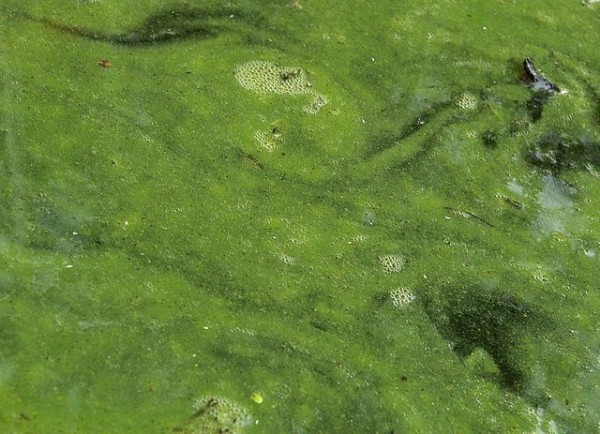Cyanobacteria Algae Poisoning Drinking Water in the UK
| Marco Foronda | | Feb 27, 2015 09:49 AM EST |
(Photo : wikipedia.org) "Bloom" of cyanobacteria in a pond.
Potentially toxic microbes that pose a threat to drinking water have undergone a dramatic population explosion over the last 200 years as a result of pollution, said experts from the University of Nottingham.
Scientists discovered that populations of cyanobacteria - also known as blue-green algae - have increased in Britain's waterways since the 1800s. The algae has been linked to neurodegenerative diseases such as Alzheimer's, Parkinson's and Lou Gehrig's disease.
Like Us on Facebook
Scientists looked at more than 100 lakes, including those in the Lake District and the West Midland Meres.
The research is the first study to show that a rise in the algae's available nutrient sources -- nitrogen and phosphorus -- commonly resulting from industrial fertilizers and sewage discharge, is the biggest culprit responsible for the increase in such a large number of lakes, across such a large geographical area.
The study also found that climate change can exacerbate this problem, with water management challenges likely to increase in a future warmer world.
The study was conducted in collaboration with academics at McGill University in Canada and other collaborators.
In addition, environmental costs associated with this alga were estimated to exceed US$100 million per year in both the UK and Australia.
The analysis showed that 58 percent of lakes saw significant increase in concentration of blue-green algae pigments during the last 200 years. Scientists believe the rise is being caused by pollution from industrial sights and sewers.
The first signs of exposure to the harmful algae are skin rash or irritation, gastroenteritis and respiratory distress.
The study was published in the journal Ecology Letters.
TagsCyanobacteria Algae, algae, blue-green algae, drinking water, lake, water poison, rashes, Alzheimer’s, Parkinson’s disease, Lou Gehrig’s disease.
©2015 Chinatopix All rights reserved. Do not reproduce without permission
EDITOR'S PICKS
-

Did the Trump administration just announce plans for a trade war with ‘hostile’ China and Russia?
-

US Senate passes Taiwan travel bill slammed by China
-

As Yan Sihong’s family grieves, here are other Chinese students who went missing abroad. Some have never been found
-

Beijing blasts Western critics who ‘smear China’ with the term sharp power
-

China Envoy Seeks to Defuse Tensions With U.S. as a Trade War Brews
-

Singapore's Deputy PM Provides Bitcoin Vote of Confidence Amid China's Blanket Bans
-

China warns investors over risks in overseas virtual currency trading
-

Chinese government most trustworthy: survey
-

Kashima Antlers On Course For Back-To-Back Titles
MOST POPULAR
LATEST NEWS
Zhou Yongkang: China's Former Security Chief Sentenced to Life in Prison

China's former Chief of the Ministry of Public Security, Zhou Yongkang, has been given a life sentence after he was found guilty of abusing his office, bribery and deliberately ... Full Article
TRENDING STORY

China Pork Prices Expected to Stabilize As The Supplies Recover

Elephone P9000 Smartphone is now on Sale on Amazon India

There's a Big Chance Cliffhangers Won't Still Be Resolved When Grey's Anatomy Season 13 Returns

Supreme Court Ruled on Samsung vs Apple Dispute for Patent Infringement

Microsoft Surface Pro 5 Rumors and Release Date: What is the Latest?










